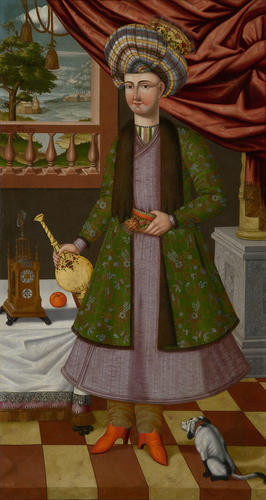-
1 of 253523 objects
Reza the Ghizilbash 1640-50
Oil on canvas | 163.5 x 87.4 cm (support, canvas/panel/stretcher external) | RCIN 407811

Marcos (active 1640s)
Reza the Ghizilbash 1640-50
-
One of three single-figure paintings signed by Marcos (with RCINs 407299 and 407300), an otherwise unknown Armenian painter active in Isfahan, the cosmopolitan capital of Persia in the 17th century.
This male figure forms a pair with RCIN 407299. A handwritten inscription on the reverse of the canvas in Armenian reads ‘Reza the Ghizilbash’, labelling him a member of the military aristocracy of Safavid Persia. He wears typical 17th century Persian attire comprising a large striped turban; a silk brocade, fur-lined jacket worn over a long, quilted silk robe tied at the waist with an embroidered silk sash; over a striped cotton undershirt. His cotton trousers tuck inside leather heeled ankle boots of a type that gained popularity in the courts of Europe. One hand grips his waist sash while the other holds a gold, jewel-encrusted Persian wine bottle. On the table beside him is an orange, a fruit which typically accompanied wine in Safavid Persia.
In composition, the three paintings of this group derive from European full-length portraits. The figures pose facing the viewer on chequerboard tiled floors; to one side is a pillar partially covered by a heavy curtain; on the other, a window balustrade opens onto a pastoral vista; and beside each figures is a fabric-covered table bearing assorted European luxury wares. The clock in this painting is thought to derive from a German model although its faces comprise unintelligible roman numerals. Below the figure is another seemingly transcontinental import: a small lap dog with a red leather collar. Such ‘foreign’ inclusions are the equivalent of Oriental rugs and Asian porcelain depicted in contemporary European portraits as signifiers of affluence through access to luxury commodities.
A large inscription on the balcony to the left of the figure names the painter and is written in both Latin (‘Marcos Fecit’) and Armenian. Just over twenty other single-figure paintings on canvas from Safavid Persia are known, but none are signed or attributed to a named artist. Marcos is believed to be one of many Armenian painters working in Isfahan in the 17th century. Another documented artist, Minas, is known to have trained with a Dutch painter in Aleppo before he established himself in Isfahan around 1630 and subsequently taught a generation of painters in a variety of media (‘in oil and without oil’ and on ‘paper, canvas, board, copper and on the wall’).
This type of Safavid single-figure painting closely corresponds to the wall paintings found in the merchants’ houses of New Julfa, the Armenian district of Isfahan. These murals are thought to depict the different indigenous groups who lived in Isfahan in their various styles of dress (Persian, Turkish, Armenian, Georgian, Indian and European). All three of the paintings in the Royal Collection similarly show different indigenous ‘types’ and depict vessels which allude to wine-drinking suggesting that they were intended to decorate entertaining spaces. The figures of the male-female pair (RCINs 407811 and 407299) as well as the objects that surround them and the elements of their dress all appear in other Safavid paintings by different hands, indicating the use of cartoons and pattern books by their artists.
In all three of Marcos’s paintings he focused heavily on the structure and layering of fabrics, perhaps unsurprising given the central role of New Julfan merchants in the international textile trade. Infrared analysis suggests the patterns for his fabrics existed on separate cartoons to those used for their shape and structure. The artist also applied small metal flakes (now tarnished) to the paint surface to mimic metal thread.
It is unknown how or when the three paintings arrived in England but their English Chinoiserie style frames are 17th century. The two female paintings are likely to be the ‘Two Indian women, at length’ which appear in James II’s inventory of Windsor Castle in 1688 and the male was apparently separated from them at that point. All three canvases have the same thin primary layer of varnish but a further layer was applied to the paintings of the two women. These later hung at Kensington Palace and Hampton Court Palace (described in inventories as either ‘Indian’ or “Chinese’) before returning to Windsor Castle where they were first recorded with this painting in 1872.
Provenance
First certainly recorded in the Page's Waiting Room at Hampton Court in 1835 (no 554)
-
Creator(s)
-
Medium and techniques
Oil on canvas
Measurements
163.5 x 87.4 cm (support, canvas/panel/stretcher external)
Alternative title(s)
Qizilbash Reza
Qizilbash Reza